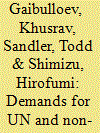| Srl | Item |
| 1 |
ID:
092046


|
|
|
|
|
| Publication |
2009.
|
| Summary/Abstract |
This article presents alternative estimates for the demand for UN and non-UN peacekeeping. Generally, three-way fixed-effects models, which account for the country, year, and conflict region, provide the best estimates. The demand for UN peacekeeping is primarily influenced by the contributions of other nations (i.e., spillins), with spillin elasticity not significantly different from 1. For non-UN peacekeeping, both spillins and country-specific interests in the conflict region influence contributions. These peacekeepers' interests include trade and FDI concerns, along with proximity to the conflict. Peacekeeping missions appear partitioned: UN missions for global public benefits and non-UN missions for peacekeeper-specific benefits.
|
|
|
|
|
|
|
|
|
|
|
|
|
|
|
|
| 2 |
ID:
155778


|
|
|
|
|
| Summary/Abstract |
This article takes stock of some of the important contributions to the study of peacekeeping (PK). Two key topics stand out: peacekeeping burden sharing and mission effectiveness. For burden sharing, the theoretical foundation is the private provision of public goods and joint products. Implications for burden sharing differ whether financial or troop contributions are being shared, with the latter driven by jointly produced country-specific benefits. Financial burden sharing can also differ between United Nations (UN)-led and non-UN-led peacekeeping operations, wherein country-specific benefits are especially important for the latter. Many articles gauge peacekeeping effectiveness by the mission’s ability to maintain the peace or to protect lives for a set time period. More recently, multiple criteria are raised for evaluating peacekeeping in today’s world of multifaceted peacebuilding operations.
|
|
|
|
|
|
|
|
|
|
|
|
|
|
|
|
| 3 |
ID:
171966


|
|
|
|
|
| Summary/Abstract |
In the past two decades, regional organizations and coalitions of states have deployed more peace operations than the UN. Yet most quantitative studies of peacekeeping effectiveness focus on UN peacekeeping exclusively, a decision owed to data availability more than to theories about the differential impact of UN and non-UN missions. As a result, we know little about the effectiveness of non-UN peacekeeping in mitigating violence. In this paper, we introduce and analyse monthly data on the approximate number of troops, police, and observers in both UN and non-UN peacekeeping operations between 1993 and 2016. Using these data, we show that when accounting for mission size and composition, UN and regional peacekeeping operations are equally effective in mitigating violence against civilians by governments, but only UN troops and police curb civilian targeting by non-state actors. We offer some theoretical reflections on these findings, but the main contribution of the article is the novel dataset on non-UN peacekeeping strength and personnel composition to overcome the near-exclusive focus on UN missions in the scholarship on peacekeeping effectiveness.
|
|
|
|
|
|
|
|
|
|
|
|
|
|
|
|